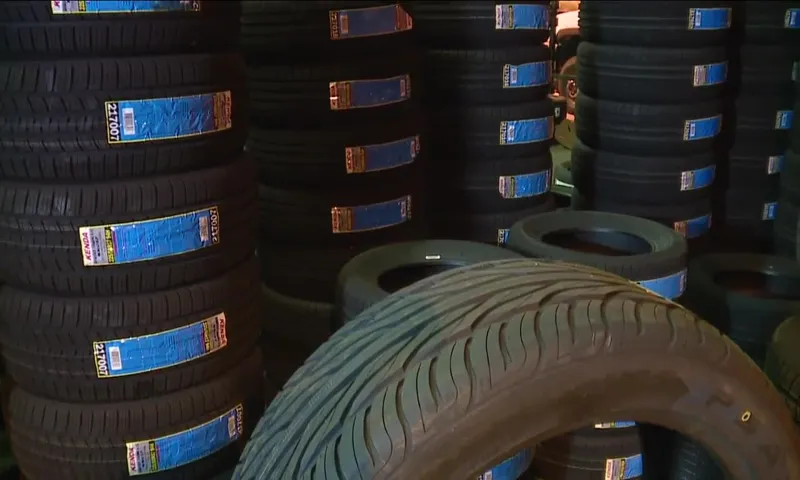We’ve all heard the rumors: “Oh, there’s a tire shortage, you better stock up!” But what’s really going on with this seemingly random disruption in our supply chains? Well, unfortunately, it’s not so random. The tire shortage is a real issue that’s affecting various industries, from car manufacturing to bicycle shops. So when will it end? First, let’s take a closer look at why there’s a tire shortage in the first place.
The pandemic has thrown a wrench in many industries, and the tire industry is no exception. With factories shutting down, employees getting sick, and shipping delays, the production of tires has been severely impacted. Combine that with the recent surge in demand for vehicles, bikes, and outdoor activities, and you’ve got a recipe for a tire shortage.
So, when will this all be over? Unfortunately, it’s hard to say. The pandemic is still ongoing, and with new variants spreading rapidly, there’s no telling when things will return to “normal.” However, some experts predict that the tire shortage could start to ease up by the end of 2021 or early 202
Manufacturers are working hard to ramp up production, and as more people get vaccinated and life starts to return to some semblance of normalcy, demand for tires may stabilize. In the meantime, what can we do? If you’re in the market for new tires, it may be worth calling around to different vendors to see if they have any in stock. You could also consider alternative transportation options, like walking or biking, to save your current tires until new ones become available.
And if you do find yourself in need of new tires, be prepared to pay a premium. With demand so high and supply so low, prices have gone up across the board. In conclusion, the tire shortage is a real issue that’s affecting many industries.
While it’s hard to say when it will end, experts predict that things may start to get better by the end of 2021 or early 202 In the meantime, it’s important to practice patience and consider alternative transportation options if possible. And if you do need new tires, be prepared to pay a bit more than usual.
Table of Contents
Current State of the Tire Industry
The tire industry has been experiencing a shortage for quite some time now, and the question on everyone’s mind is when it will end. The pandemic has undoubtedly contributed to the situation, as factories and supply chains were disrupted, causing a decrease in production and an increase in demand. However, it is not only the pandemic that is causing the shortage.
Other factors, such as the shortage of raw materials, a decrease in the number of shipping containers, and even the latest winter storm in Texas, have all played a role in exacerbating the situation. Despite efforts from tire manufacturers to increase production, the shortage is expected to last for several more months, if not longer. The good news, though, is that the industry is adapting and finding new ways to manage the situation, so we can expect some relief in the future.
As for the question of when the tire shortage will end, it’s difficult to say for sure, but as with any supply and demand issue, it will eventually work itself out.
Supply Chain Challenges
The tire industry faces many supply chain challenges, starting from the sourcing of raw materials to transporting finished products to end-users. The current state of the industry is marked by fluctuating prices, rising demand, and complexity in production processes. Raw materials availability, including natural rubber, petroleum-based chemicals, and synthetic rubber, is dependent on different factors such as climate change, trade war, and geopolitics.
Moreover, the transportation system that moves raw materials and finished products worldwide is subject to disruption due to geopolitical risks, port congestion, and COVID-1 This has made it challenging for tire manufacturers and suppliers to keep up with demand. The challenge is exacerbated by the fact that the tire industry supply chain is quite long, involving different segments such as raw material suppliers, tire manufacturers, distributors, and retailers.
In light of these challenges, the industry needs to optimize their supply chain and adopt technologies that will enhance their resiliency and flexibility in the face of unexpected disturbances.

Increase in Demand
The tire industry is experiencing a surge in demand, driven by a range of factors. Rapid growth in the automotive sector has led to an increase in the production of cars, trucks, and other vehicles, which in turn has increased the demand for new tires. Additionally, the rise of e-commerce and online retail has made it easier for consumers to access a wider range of tire products, driving up demand even further.
Another important factor is the growing interest in sustainability and eco-friendliness, which has led to an increased demand for environmentally-friendly tire options. Overall, the current state of the tire industry is one of growth and innovation, and there is no end in sight to the increased demand for this essential product. So, whether you are a vehicle owner or a tire industry professional, there has never been a better time to be part of this exciting and dynamic market.
Factors Affecting the End of the Shortage
Are you constantly wondering when the tire shortage will come to an end? You’re not alone. While there is no definitive answer, there are several factors that can affect the timeline. Firstly, the global supply chain disruptions caused by the pandemic have contributed to creating the shortage.
As vaccination rates increase, and life slowly returns to normal, manufacturing and shipping industries have started to stabilize. Consequently, tire production has also begun to recover, leading to increased supply. Secondly, economic policies such as government-imposed trade barriers and taxes can also affect the availability of tires.
Lastly, the market demand for certain types of tires can fluctuate, causing shortages. However, the tire industry is doing its best to keep up with the demand and mitigate the shortage. So, while the end of the tire shortage is not definite, the signs are positively pointing towards a more stable future.
Global Tire Production
Global Tire Production After suffering from a shortage for the past year, the global tire industry may finally see an end in sight. There are several factors that will contribute to an increase in tire production. One key factor is the return of pre-pandemic demand levels.
As economies begin to recover and people start to travel more frequently, there will be an uptick in demand for new tires. Additionally, many tire manufacturers have invested in expanding their production capacities, which will increase the overall supply of tires available in the market. Finally, a decrease in the cost of rubber, the primary raw material used in tire production, will enable manufacturers to produce more tires at a lower cost, which will in turn benefit consumers.
While the tire shortage has certainly been frustrating for many, the industry is optimistic that these various factors will help bring it to an end.
Raw Material Supply and Availability
Raw material supply and availability are crucial factors that affect the end of the shortage in the manufacturing industry. The global pandemic has caused disruptions in the supply chain, leading to a shortage of materials such as semiconductor chips, metals, and plastics. However, as countries have started to reopen their economies, the demand for raw materials has also increased.
The shortage could be alleviated by increasing supplies through production facilities, expanding imports, and finding alternative sources of raw materials. The industry could also adopt sustainable practices to reduce dependence on scarce resources and promote waste reduction. Additionally, advancements in technology and innovation may lead to the development of new materials that can replace scarce resources.
Overall, the shortage may ease as the supply chain adapts to the changing market conditions, and the industry takes proactive steps to address its raw material needs.
Logistics and Shipping Challenges
As the pandemic disrupted supply chains around the world, the logistics and shipping industry faced unprecedented challenges. The shortage of shipping containers and the congested ports added to the already-existing issues, causing delays and price hikes. However, several factors are affecting the end of the shortage.
The increase in production and capacity of manufacturing units and the resumption of global trade have led to the availability of more containers and increased the frequency of shipping. Moreover, the deployment of advanced technologies like AI and blockchain is streamlining supply chain processes and enhancing efficiency. Additionally, the collaboration of industry stakeholders and government authorities is playing a crucial role in resolving issues and ensuring smooth operations.
As we gradually recover from the pandemic, the logistics and shipping industry is adapting to the new normal, prioritizing sustainability, and embracing innovation to tackle the challenges of the future.
Possible Solutions and Future Outlook
It’s difficult to predict exactly when the tire shortage will end, but there are possible solutions and a positive future outlook. One potential solution is to increase production capacity for tires. Many tire manufacturers have already made investments to expand their production capabilities, so this could lead to more tires being available in the near future.
Another solution is to encourage consumers to prioritize their tire needs, such as by purchasing all-season tires that can be used year-round instead of buying separate winter and summer tires. This would help to distribute the demand for tires more evenly throughout the year. In terms of the future outlook, there is reason for optimism.
The global tire industry is projected to grow over the next several years, with increasing demand for tires in emerging markets such as Asia and Africa. This growth could lead to new investments in tire production and increased competition, which could ultimately benefit consumers. While the current tire shortage is certainly challenging, it’s important to remember that there are possible solutions and that the future outlook is hopeful.
Investment in Domestic Production
Investment in Domestic Production Investing in domestic production has become an increasingly popular solution for countries looking to reduce their reliance on foreign goods and stimulate economic growth. One way to encourage investment in domestic production is through the implementation of policies such as tax incentives and subsidies for companies that produce goods locally. Another solution is to establish government-funded research and development programs that focus on improving domestic production capabilities and competitiveness.
Additionally, reshoring manufacturing jobs and technology that were previously offshore can also help to revitalize domestic production. To ensure a bright future for investment in domestic production, it is crucial to focus on sustainability and innovative technology. The incorporation of eco-friendly materials and processes not only benefits the environment but also attracts socially conscious consumers.
Advancements in technology such as automation and artificial intelligence can also improve productivity and reduce costs for companies. Furthermore, it’s important to remember that investment in domestic production shouldn’t come at the expense of global trade and collaboration. By successfully balancing domestic production with international trade, we can create a mutually beneficial global economy that promotes growth and stability.
In conclusion, investment in domestic production can have numerous benefits for both countries and economies. By establishing policies and programs that incentivize local production and prioritizing sustainability and innovation, we can create a bright future for domestic production. Moreover, balancing domestic production with international trade and collaboration can help us achieve a mutually beneficial global economy.
Alternative Materials and Technologies
As the effects of climate change become more evident, scientists and engineers are continuously searching for alternative materials and technologies to reduce the carbon footprint. One potential solution gaining popularity is the use of bioplastics, which are derived from renewable resources such as cornstarch or sugarcane. These materials offer a sustainable alternative to traditional plastics, which are typically made from fossil fuels.
Additionally, advancements in carbon capture technologies offer hope for reducing emissions from industries such as manufacturing and energy production. Improvements in energy storage technologies, such as the development of more efficient batteries, will also play a crucial role in the transition to clean energy. While there is still much work to be done, the increasing availability and affordability of these and other sustainable alternatives provide a hopeful outlook for the future.
Conclusion
When will the tire shortage end? Well, much like a flat tire on a road trip, it’s hard to say exactly when it will be fully fixed. But we can hope that the industry will pump up production and find innovative solutions to keep us rolling smoothly. Until then, may we all have a spare in our trunks and a sense of humor to get us through the bumps in the road.
“
FAQs
What caused the tire shortage?
The tire shortage was caused by a combination of factors such as COVID-19 related shutdowns, supply chain disruptions, and high demand.
How long has the tire shortage been going on?
The tire shortage started in 2020 and has continued into 2021 with no clear end date.
When will tire production return to normal?
It is difficult to determine when tire production will return to normal, as it is dependent on various factors such as the pandemic situation and global supply chain issues.
Will the tire shortage affect prices?
Yes, the tire shortage has already resulted in price increases for tires due to limited supply and increased demand.
Can I still purchase tires during the shortage?
Yes, tires are still available but there may be limited options and longer wait times due to the shortage.
Will the tire shortage affect safety on the road?
The tire shortage could potentially affect safety on the road if drivers continue to use worn-out tires or delay necessary replacements due to limited availability.
Is the tire shortage just affecting certain types of tires?
No, the tire shortage is affecting all types of tires, including passenger tires, commercial tires, and specialty tires.



